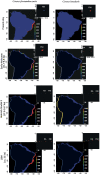A historical stepping-stone path for an island-colonizing cactus across a submerged "bridge" archipelago
- PMID: 38637723
- PMCID: PMC11166651
- DOI: 10.1038/s41437-024-00683-4
A historical stepping-stone path for an island-colonizing cactus across a submerged "bridge" archipelago
Abstract
Here we use population genomic data (ddRAD-Seq) and ecological niche modeling to test biogeographic hypotheses for the divergence of the island-endemic cactus species Cereus insularis Hemsl. (Cereeae; Cactaceae) from its sister species C. fernambucensis Lem. The Cereus insularis grows in the Fernando de Noronha Islands (FNI), a Neotropical archipelago located 350 km off the Brazilian Atlantic Forest (BAF) coast. Phylogeographic reconstructions support a northward expansion by the common ancestor of C. insularis and C. fernambucensis along the mainland BAF coast, with C. insularis diverging from the widespread mainland taxon C. fernambucensis after colonizing FNI in the late Pleistocene. The morphologically distinct C. insularis is monophyletic and nested within C. fernambucensis, as expected from a progenitor-derivative speciation model. We tested alternative biogeographic and demographic hypotheses for the colonization of the FNI using Approximate Bayesian Computation. We found the greatest support for a stepping-stone path that emerged during periods of decreased sea level (the "bridge" hypothesis), in congruence with historical ecological niche modeling that shows highly suitable habitats on stepping-stone islands during glacial periods. The outlier analyses reveal signatures of selection in C. insularis, suggesting a putative role of adaptation driving rapid anagenic differentiation of this species in FNI.
© 2024. The Author(s), under exclusive licence to The Genetics Society.
Conflict of interest statement
The authors declare no competing interests.
Figures





References
-
- Amaral DT, Minhós-Yano I, Oliveira JVM, Romeiro-Brito M, Bonatelli IAS, Taylor NP, et al. Tracking the xeric biomes of South America: the spatiotemporal diversification of Mandacaru cactus. J Biogeogr. 2021;48:3085–3103. doi: 10.1111/jbi.14265. - DOI
-
- Barton NH, Charlesworth B. Genetic revolutions, founder effects, and speciation. Annu Rev Ecol Evol Syst. 1984;15:133–164. doi: 10.1146/annurev.es.15.110184.001025. - DOI
Publication types
MeSH terms
Grants and funding
- 402209/2016-8/Ministry of Science, Technology and Innovation | Conselho Nacional de Desenvolvimento Científico e Tecnológico (National Council for Scientific and Technological Development)
- 305301/2018-7/Ministry of Science, Technology and Innovation | Conselho Nacional de Desenvolvimento Científico e Tecnológico (National Council for Scientific and Technological Development)
- Finantial Code 001/Coordenação de Aperfeiçoamento de Pessoal de Nível Superior (Brazilian Federal Agency for the Support and Evaluation of Graduate Education)
LinkOut - more resources
Full Text Sources

